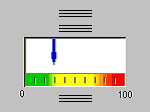1.In the Navigation tree, expand Windows(R) Systems -> <Windows host name> -> Windows OS.
2.Click Memory to display the Memory workspace.
3.Split the Memory Allocation view horizontally.
4.Click the Notepad icon and add it to one of the new windows that you created in the previous step.
5.Click the Linear Gauge icon and click inside the Notepad view.
6.Select Yes in the Select option window.
7.Do the following to assign a query to the gauge:
a.Click Click here to assign a query.
b.Expand Windows OS -> NT_Memory.
c.Click Memory Allocation.
d.Click OK.
8.Click the Filters tab.
9.Select Available Bytes and click Apply.
10.Do the following to change the appearance of the gauge, including the range of values:
a.Click the Style tab.
b.Click the Linear Gauge icon.
c.On the Scale tab, change the color to blue.
d.On the Needle tab, change the Style to pointer and the Width to 10.
e.On the Range tab, clear the Use default boxes.
f.Type 0 in the Minimum Value field.
g.Type a value greater than the total bytes available (shown in the Preview gauge) in the Maximum Value field. For example, if your total bytes available is 111362048, type 120000000.
h.Click Edit Subranges to add threshold coloring.
i.Click Create New.
ii.Type a name to create for definition and click OK.
iii.Select the color yellow from the list.
iv.In the Minimum Value and Maximum Value fields, type two numbers between the minimum and maximum range for the gauge. For example, for the minimum value, type 60026016 and for the maximum value, 72251219. (These values are between 0 and 12000000, the range for the gauge.)
v.Click Apply and click OK.
11.Click Apply and then OK.
The new linear gauge is displayed in the workspace.
12.Try creating a Circular Gauge view by repeating steps 1 through 11.
Basic product function

